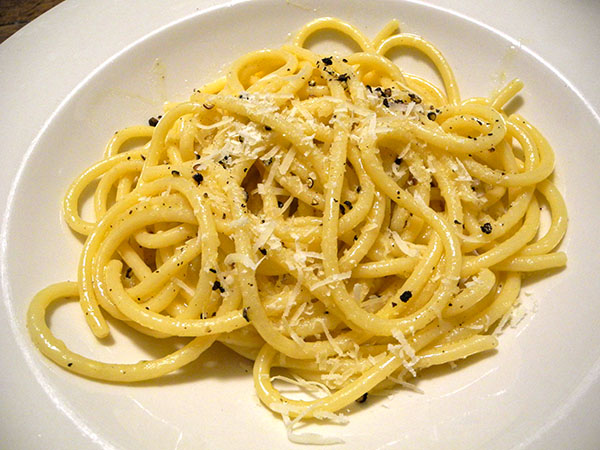
There are few dishes simpler to put together than this one, and almost none which would be as satisfying – regardless of how hungry a diner might be.
Last night I didn’t have a thin pasta like bavette, a linguine fini, or even a penne, each of which I believe I have sometimes used over the years, so I cut open a one-kilo package of bigoli instead and weighted out 8 ounces. I thought I had violated a tradition in using these thick long tubes, but when I went on line later to check on what the classic cacio e pepe was, I came across a number of sites describing bigoli as the pasta of choice.
There also seems to be some disagreement about the cheese of choice: Most recipes indicate pecorino, some pecorino Romano and Parmigiano-Reggiano, and I’ve also seen ‘Cacio di Roma’ paired with pecorino Romano.
I’ve generally gone with pecorino Romano and Parmigiano-Reggiano myself, because that’s where my experience with this dish started, 15 years ago, and also because I have a soft spot for Amanda Hesser and her food writing.
The recipe is quite simple, and I’ve never really wandered from the original, described here, although without the charming introduction included in the original, 2002 article in the New York Times.
These are the ingredients I used this time:
- eight ounces of Setaro Bucatini from Buon Italia; Baleine coarse sea salt; almost a quarter cup each of pecorino Romano from Whole Foods and Parmigiano Reggiano Vacche Rosse from Buon Italia; 2 tablespoons of Kerrygold Pure Irish Butter; 2 tablespoons of Greek olive oil from Trader Joe’s; one full tablespoon of black pepper, coarsely ground as usual [in my ancient wooden mortar and pestle]
- the wine was an Italian (Marche) white, Saladini Pilastri Falerio 2015, from Phillippe Wines
- the music was Rameau’s one-act acte-de-ballet, the 1754 ‘Anacreon’, Jonathan Williams conducting the Orchestra Of The Age Of Enlightenment and the Choir Of The Enlightenment